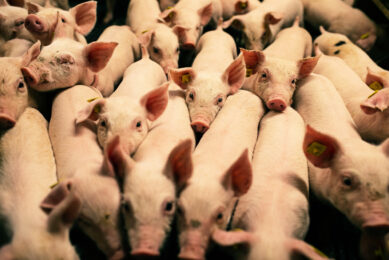Nutritional solutions to Edema Disease
Edema or oedema, depending whether you are in the USA or UK, respectively, is a frequent gastrointestinal disorder affecting millions of pigs each year. Scours, loss of appetite, depressed performance and overall condition are all consequences of this infective disease.
Edema or oedema, depending whether you are in the USA or UK, respectively, is a frequent gastrointestinal disorder affecting millions of pigs each year. Scours, loss of appetite, depressed performance and overall condition are all consequences of this infective disease.
It is beyond the scope of this article to offer veterinary advice. In contrast, the advice of a qualified practicing veterinarian is strongly advocated in such cases. Nevertheless, a number of nutritional intervention strategies are available to at least alleviate the symptoms of this disease, if not completely prevent or cure it. It must be emphasized here that not all such nutritional strategies work in every farm, so their employment should be considered as part of a greater overall program against edema.
Protein
Most pathogenic bacteria, including Escherichia coli, feed on protein and thus, it makes sense to offer them less of a substrate to proliferate. To this end, the dietary protein levels may be dropped by 2-4%, keeping the amino acid ideal profile. To the same effect, increasing dietary protein digestibility also helps reduce undigested protein reaching the hindgut, because, increased digestibility reduces dietary specifications for total levels of protein.
Minerals
The use of zinc oxide, where allowed, at levels up to 3000 ppm of Zn in complete feed has also been shown to help in most cases of pathogenic diarrhea. It is best to gradually reduce its inclusion level to 2000 and then 1000ppm throughout the nursery period to avoid depression of feed intake. Also, copper sulfate, again where allowed, up to 250 ppm in complete feed is also beneficial against scours, especially during the later stages of the nursery period. It has also been shown that reducing the amount of calcium in the diet improves stomach pH conditions, creating thus a less favorable environment for bacterial growth. Finally, it is important to keep in mind that E. coli thrive on an iron-rich substrate, and thus it might be beneficial to limit this nutrient to minimal levels required for growth.
Ingredients
It is quite common knowledge the fact that reducing or removing soybean meal from the piglet diets greatly reduces the incidence of gastrointestinal infections, including edema disease. Although removal of soybean meal would markedly increase feed cost, this is not completely unfeasible in the post-weaning diets. Naturally, organic acids are also quite helpful against bacteria growth as they tend to create an acidic environment throughout the gastrointestinal tract, and especially in the stomach. In this end, blends of organic acids are usually better than straight acids. There are also claims that betaine might reduce the symptoms of diarrhea, acting as a strong osmotic regulator, but for this I am prepared to review more data before I am thoroughly convinced!
Management
Beyond the obvious suggestion of enhancing biosecurity, sanitation, and overall animal housing conditions, there a couple less known strategies of reducing diarrheas. First, limiting feed intake during the first four-five days post-weaning is strongly advocated in cases of high infective stress as this strategy reduces the amount of undigested feed reaching the hindgut. Also, the use of coarsely ground cereals instead of fine ones, and only uncooked, has been shown to further increase the overall health of the digestive tract in cases of severe bacterial infections. Although these two intervention strategies are quite powerful in controlling scours, they also limit animal performance, so they should be employed with care.











